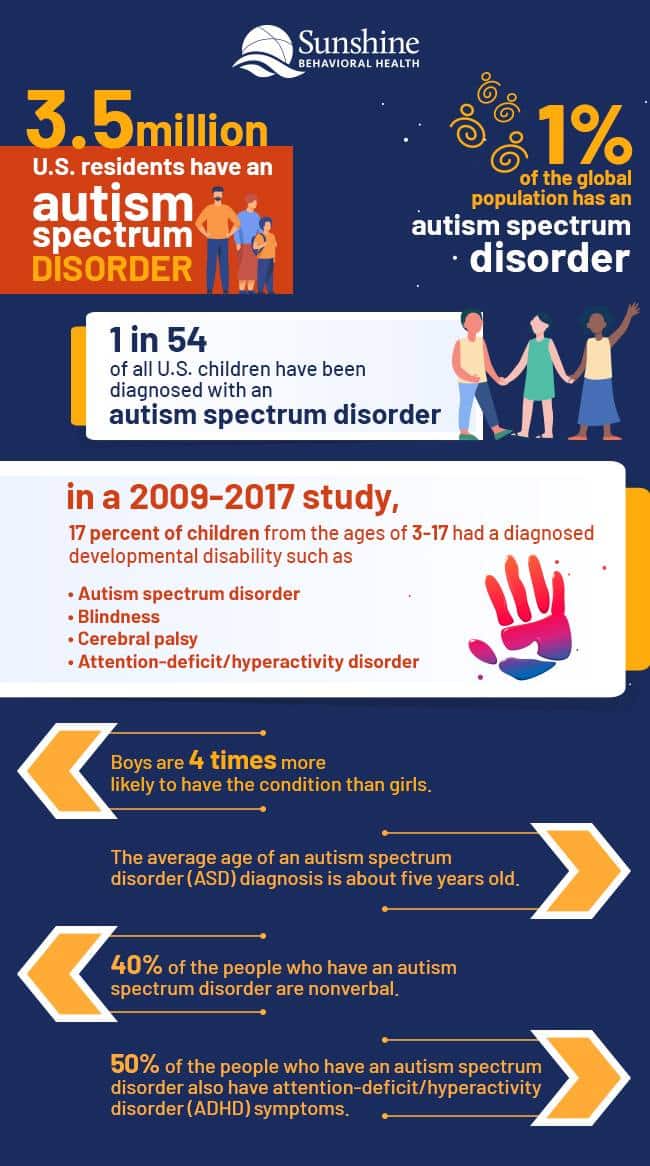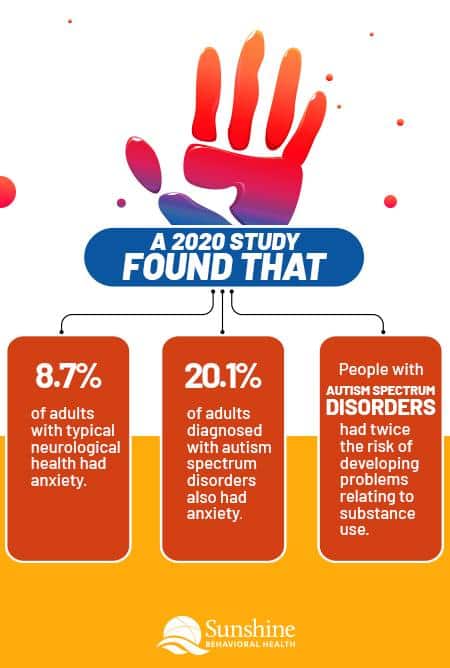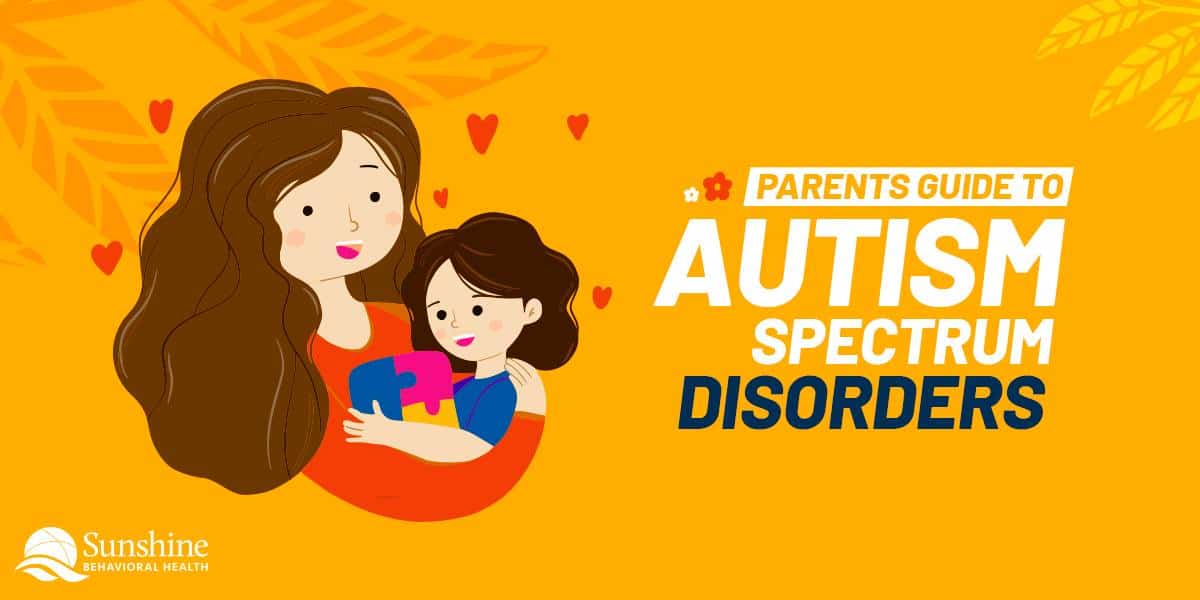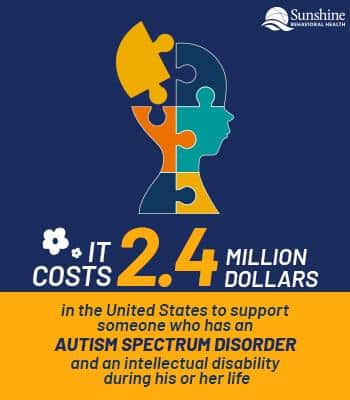We often hear about autism, but we might not know what it is. It could be useful to describe the condition and how it affects the people with it as well as the people who love them.
What are autism spectrum disorders (autism)?
Technically, autism is known as autism spectrum disorder (ASDs), which means the conditions encompass a range of
- Behaviors
- Language and communication skills
- Cognitive abilities
- Symptoms
ASDs are neurodevelopmental disorders that affect people’s brains as well as their social and communication skills. They also feature behaviors that are restricted or repetitive. The term autism spectrum disorders consists of conditions that were once separate diagnoses:
- Classic autism: A severe form of autism that includes social and communication difficulties, intense interests, sensitivity relating to the senses, and inflexible and/or repetitive behavior.
- Childhood disintegrative disorder: Also known by the names Heller’s syndrome and disintegrative psychosis, this condition occurs when older children experience developmental delays.
- Rett syndrome: Marked by repetitive hand gestures, movement problems, other impairments, and the loss of skills, this neurological condition is more common in girls than in boys.
- Asperger syndrome: Also known as Asperger’s syndrome and Asperger’s, people with this condition often have an intense interest in particular topics, repetitive behaviors and language, social differences, and other symptoms characteristic of ASDs.
- Pervasive developmental disorder not otherwise specified (PDD-NOS): This term is used for people who are on the autism spectrum but don’t have all the criteria for other autistic diagnoses or have mild symptoms.
Thus, autism spectrum disorders is a broad term for a complex disorder.

What are some symptoms of autism spectrum disorders?
Problems with communication and social skills are common in people with autism spectrum disorders (ASDs). Children and adults with the condition might not:
- Continue to progress developmentally or lose skills they once had.
- Make eye contact with others.
- Hold conversations with others easily.
- Associate with others and instead prefer to be by themselves.
- Engage in displays of affection.
- Recognize emotions or body language, understand relationships, or provide expected social responses.
- Share, give, or show things that interest them.
- Point or look at items they or other people are discussing.
- Respond to their own names.
Repetitive and restricted behaviors are also common in ASDs. People with ASDs might:
- Organize, sort, or line up items instead of playing with them or using them.
- Display intense interest in subjects or items.
- Repeat actions (rock back and forth, flap the arms) or speech (saying words over and over again) to soothe themselves.
- Be distressed when facing small changes in their routines.
- Experience sensitivity related to their senses.
Not all people with ASDs have each of these symptoms. People also experience different severity levels of such symptoms, which is why the conditions are part of a spectrum.
What causes autism spectrum disorders?
As with other conditions, scientists aren’t certain what causes autism spectrum disorders (ASDs) but believe that:
- Genes may make people more likely to develop ASDs.
- Older parents are more likely to have biological children with ASDs.
- Some chromosomal or genetic conditions may increase the chances of ASDs.
- Pregnant women who take medications such as thalidomide and valproic acid may have an increased likelihood of having children with ASDs.
- Children who have siblings with ASDs also have a higher risk of having ASDs.
Scientists also believe that there are critical times that may affect when someone develops the conditions. These times are before, during, and soon after birth.
How are autism spectrum disorders diagnosed?
Although it appears that people develop autism spectrum disorders (ASDs) early in their lives, they receive diagnoses at different ages.
After analyzing the results of several studies around the world, researchers determined that the average age of an ASD diagnosis is about five years old. When they narrowed their focus to studies that followed children younger than 10 years old, the researchers found that the average age for an ASD diagnosis was 43.18 months, or about three and half years old.
Diagnosing ASDs is typically a multistep process. In the first part, doctors determine if children are progressing and meeting all their developmental milestones, a process known as developmental monitoring. This monitoring often occurs during regularly scheduled checkups as children progress from being infants, to toddlers, to children of different ages.
In the second part, developmental screening, professionals try to determine whether children have ASDs by giving children tests and/or their parents questionnaires. Such screening may happen as part of the checkup process. It also may occur if doctors or other professionals think children may have higher risks of developing ASDs because they were premature, have siblings with the condition, or have health conditions or other factors that merit additional attention.
Following such monitoring and screening, if professionals think that children might have ASDs or other disorders, they might request developmental evaluations to determine whether the children need treatment, intervention, or other assistance.
 What does an autism spectrum disorder diagnosis mean for my child?
What does an autism spectrum disorder diagnosis mean for my child?
Since people with autism spectrum disorders (ASDs) have different symptoms, their diagnoses and potential outcomes are also different.
Children and adults with more severe ASDs might need more assistance and so might their family members and friends. Loved ones might be shocked and stunned, mourning the lives they imagined for themselves. Or, they might be relieved to know that their problems are real, have names, and that there are ways to understand and treat them.
There are many resources for understanding and treating ASDs and other conditions. After a diagnosis, concerned friends and relatives might want to order a copy of the 100 Day Kit for Young Children from Autism Speaks. This kit explains autism and its diagnosis, describes symptoms and behaviors, gives resources, and provides weekly plans.
Addressing and diagnosing ASDs instead of ignoring or minimizing them can help people with ASDs and the people who care about them.
What are some medications for children on the autism spectrum?
Given the range of symptoms and complexity of the conditions, there are no cures for autism spectrum disorders. Medications won’t eliminate the conditions.
But some medications may alleviate some aspects of ASDs. These prescription drugs include:
- Antipsychotic or psychoactive medications: Prescription drugs that may decrease aggression, hyperactivity, repeated behaviors, and irritability
- Tricyclic antidepressants: Medications that are prescribed for obsessive-compulsive disorder (OCD) and depression
- Selective serotonin reuptake inhibitors (SSRIs): Antidepressants that might reduce aggressive behavior, anger, irritability, and anxiety; improve the ability to make eye contact; minimize how much and how often people display repetitive behaviors
- Stimulants: Stimulants could decrease hyperactivity and increase focus in people with mild ASD symptoms
- Anticonvulsants: Treatments for epilepsy might also help, since almost one-third of people with symptoms of ASD have seizures or seizure disorders
- Antianxiety prescriptions: Drugs that could alleviate panic disorders and anxiety, conditions that are often related to ASD
Talking with doctors, mental health professionals, teachers, and others can help people determine how to approach autism spectrum disorders and how to treat them.
How are autism spectrum disorders related to other conditions and disorders?
As with other conditions, autism spectrum disorders can relate to other physical and mental conditions and disorders. These include:
Autism spectrum disorders and epilepsy
About a third of people who have autism spectrum disorders also have epilepsy. Diagnosing both might be difficult because the symptoms of the disorders could be similar. People with ASDs may display repetitive movements that look like seizures, or their seizures may resemble ASD-type repetitive movements.
Autism and gastrointestinal (GI) disorders
Some gastrointestinal (GI) problems associated with ASDs are:
- Pain in the abdomen
- Diarrhea
- Constant constipation
Other, less common GI symptoms and conditions associated with ASDs include:
- Vomiting
- Gas
- Bloody feces
- Reflux
- Inflammation within the stomach, digestive tract, or lining of the esophagus
Autism spectrum disorders and feeding/eating issues
Since autism is linked with GI disorders, perhaps it’s not surprising that it’s also linked to feeding and eating issues.
Researchers believe that people with autism spectrum disorders have more permeable intestines. This means that the walls of their intestines are looser and are more likely to release toxins and bacteria into the bloodstream.
In addition, people with ASD may have differences in nutrient intake, disruptions in their metabolisms, and food allergies.
Autism spectrum disorders and disrupted sleep
Sleep issues and autism spectrum disorders are also linked. People with ASDs may have trouble falling or staying asleep, which could affect them and the people who are caring for them.
People with ASDs may be more likely to have sleep problems if they experience:
- Anxiety.
- Repetitive or restrictive behaviors (such as flapping their hands, rocking back and forth, or lining up objects).
- Issues with their senses (such as sensitivity about sights, sounds, and things they can touch).
To better understand their sleep conditions, people with ASDs might wear activity trackers. This wearable tech can help parents track when their children with ASP go to bed, when and how often they awake, and what happens when they don’t get enough sleep. With this data and the help of specialists, parents can manage their children’s ASD symptoms and improve their sleep quality.
Autism spectrum disorders and attention-deficit/hyperactivity disorder (ADHD)
There’s often a connection between autism spectrum disorders and attention-deficit/hyperactivity disorder (ADHD), another neurological disorder. People with ADHD may find it difficult to pay attention, stay organized, and maintain focus, among other symptoms.
More than 50% of all people who have diagnosed cases of ASDs also have ADHD symptoms. Up to 25% of children who have ADHD also have mild symptoms of ASD, including sensitivity to clothing or social problems.
Autism spectrum disorders and anxiety
Anxiety is also common for people with autism spectrum disorders. A 2020 study found that:
- 20.1% of adults diagnosed with ASDs also had anxiety.
- 8.7% of neurotypical adults (adults with typical neurological health) had anxiety.
To treat anxiety and other conditions, people with ASDs might want to consider visiting a therapist for cognitive-behavioral therapy that examines people’s thoughts, feelings, and behaviors and replaces them with more helpful approaches.
Autism spectrum disorders and obsessive-compulsive disorder (OCD)
Autism spectrum disorders are also often linked with obsessive-compulsive disorder (OCD), a psychological condition marked by agitation, repeated behaviors, and other symptoms.
Researchers in a 2015 study determined that people who have received diagnoses for ASD were twice as likely to receive a diagnosis of OCD later in their lives. People diagnosed with OCD were four times more likely to be diagnosed with ASD later.
People with ASDs often have anxiety or engage in repeated behaviors to soothe themselves, and so do people with OCD. It can be challenging to differentiate between the two or determine if people have either or both.
Autism spectrum disorders and depression
Young people and adolescents with ASDs also are more likely to have depression. Researchers have found that people with autism spectrum disorders are four times more likely to have depression during their lives.
In addition to feelings of hopelessness and physical symptoms such as tiredness, depression in people with ASDs can consist of:
- Obsessive behaviors
- Rocking behaviors
- Aggression
- Social withdrawal
- Sleep problems
Autism spectrum disorders and schizophrenia
Social withdrawal and muted emotional responses are possible symptoms of schizophrenia as well as autism spectrum disorders. Sometimes, people with ASDs also have schizophrenia.
Both conditions are related to problems with sensory processing and thinking, and brains that develop in atypical ways. Rates of ASDs are higher in children who develop schizophrenia before age 13. Schizophrenia typically occurs in late adolescence and young adulthood.
Autism spectrum disorders and bipolar disorder
Bipolar disorder, a mental illness that is marked by periods of mania and periods of depression, is another condition sometimes associated with autism spectrum disorders.
One study evaluated people who were then diagnosed with Asperger syndrome and would now be diagnosed with ASDs. It found that prescribing mood stabilizers—such as lithium and valproic acid—or second-generation antipsychotics could help treat both the symptoms of ASDs and bipolar disorder.
Autism spectrum disorders, substance use disorder, and addiction
Many people with ASDs don’t tolerate rule-breaking and might view substance use disorder and addiction as impermissible, but both appear to have ties to autism spectrum disorders.
Researchers discovered that people with ASDs and higher IQs had twice the risk of developing problems relating to substance use. If they also have attention-deficit/hyperactivity disorder (ADHD), their addiction-related risks are even higher.
Like other people with anxiety, some people with ASDs turn to drugs and alcohol as ways to cope. Using alcohol and drugs might make it easier for people with ASD to socialize, to fit in with others who are using such substances, and to cope with their sensory sensitivities.
Addiction and substance use disorder are thus not foreign to people with ASDs (or people in general).
How do parents respond to an autism spectrum disorder diagnosis?
A diagnosis of ASD can be a shock or a relief. Loved ones might be stunned after an autism spectrum disorder diagnosis because it upsets the future they imagined for themselves.
For people with ASDs and the people who love them, however, the diagnosis at least puts a name to the problem, proves that it is real and needs to be taken seriously. The challenges remain, but now there are ways to understand and treat them.
Parents of people diagnosed with ASDs might want to:
- Remind people that they’re the same children as before and that they’re people, not their diagnoses.
- Emphasize the strengths of children with ASDs (such as exceptional memories) and find things they enjoy doing together.
- Set reasonable goals for their children and work with them to accomplish them.
- Create support systems with their partners, loved ones, communities, and parents of other people diagnosed with ASDs.
- Find resources to help. Professionals, organizations, and other parents can help people navigate ASDs diagnoses and provide valuable firsthand assistance and advice.
As with other conditions, reaching out and working with others can help people affected by ASD diagnoses find assistance and hope.
Should people treat children with autism spectrum disorders differently?
Autism spectrum disorders present themselves in different ways, so people must interact with people with ASDs in various ways. Children and adults with more severe ASDs might need more assistance, and so might their family members and friends.
Some people with ASDs may not be verbal, have a difficult time communicating, or have difficulty understanding the speech or nonverbal communication of others. Some might take things literally and have trouble understanding subtleties or sarcasm, so their parents should try to be very clear when interacting with them.
When communicating with people with ASDs, people can consider these differences and preferences. Being patient is important because people with ASDs might take longer to process information.
On the other hand, ASDs aren’t excuses for poor behavior. Parents of children with ASDs should still discipline their children, ignore negative attention-seeking behavior, and reward achievements and good behavior. Teaching children how to express their anger and other feelings can prevent frustration on both sides.
Instead of assuming people with ASDs can only do certain things in a certain way, people can presume competence. In the words of The Autism Site and GreaterGood, when people presume competence, they “assume an autistic person has the capacity to think, learn, and understand.”
How can parents find help?
As overwhelming as the conditions can be, parents can remind themselves that autism spectrum disorders are diagnoses. They’re not the only aspects of their or their children’s lives.
Parents of children with ASDs can:
- Recognize the progress they and their children have made.
- Acknowledge the positive things they’re doing in the present.
- Take time for themselves.
Building support systems is also crucial. It takes a village to raise a child, and exposure to other caring people can benefit children with ASDs and the people who are raising them. Such support might be especially useful when single parents are raising children with ASDs or the caretakers need some assistance.
Letting go of the need to be perfect can also be helpful for parents, as can forgiving themselves for their mistakes. Learning from mistakes can be a more constructive way of parenting children with ASDs (or doing anything).
By learning as much as they can about ASDs, parents can help themselves and their children. While people should presume that people with autism spectrum disorders can comprehend things, understanding and addressing ASDs can be difficult for parents and others.
There are various resources to help people understand ASDs, search for treatment providers, and find support groups and other assistance.
Resources for Autism
Asperger/Autism Network
- Phone: (617)a393a3824
- Other contact information: aane.org/about-us/contact-us
Association for Science in Autism Treatment (ASAT)
- Resources: asatonline.org
- Research and treatment resources: asatonline.org/research-treatment
Autism National Committee (AutCom)
- Resources: autcom.org/resources/links
Autism Network International
- Online discussion list: autism.org/diagnostics-checklist
Autism Research Institute (ARI)
- Diagnostic checklists: autism.org/diagnostics-checklist
Autism Science Foundation
- Social media: autismsciencefoundation.org/contact-us/social-media
- Newsletter: autismsciencefoundation.org/contact-us/newsletter
Autism Society of America
- National Helpline: 800a3aAUTISM (800a328a8476)
Autism Speaks
- Autism Response Team (ART): 888aAUTISM2 (888a288a4762)
- Autism Diagnosis Kit: autismspeaks.org
- Spanish: 888a772a9050
- Email: help@autismspeaks.org
Autistic Self Advocacy Network (ASAN)
- Resources: autisticadvocacy.org
Hire Autism (The Sandy Lankler Jobs Portal)
International Society for Autism Research (INSAR)
- Phone: 816a595a4852
National Autism Association
- Phone: 877a622a2884
- Email: naa@nationalautism.org
Operation Autism (for military families)
- Resources: operationautism.org/resources
Organization for Autism Research
- Resources: researchautism.org/resources
Solving Autism
- Contact page: solvingautism.com/contact
- Email: renee@solvingautism.com
Spectrum
- Newsletter: spectrumnews.org/newsletter
Sources
Medical disclaimer:
Sunshine Behavioral Health strives to help people who are facing substance abuse, addiction, mental health disorders, or a combination of these conditions. It does this by providing compassionate care and evidence-based content that addresses health, treatment, and recovery.
Licensed medical professionals review material we publish on our site. The material is not a substitute for qualified medical diagnoses, treatment, or advice. It should not be used to replace the suggestions of your personal physician or other health care professionals.








